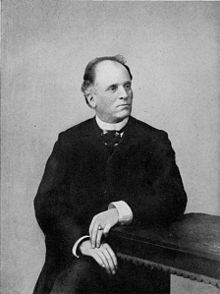Adolph Francis Alphonse Bandelier
Adolph Francis Alphonse Bandelier , also Adolphe-François Bandelier (born August 6, 1840 in Bern , † March 18, 1914 in Seville ) was a Swiss - American archaeologist who has made a name for himself in particular for researching the American Southwest . The Bandelier National Monument in New Mexico is named after him.
Life
Bandelier was born in Bern, Switzerland, and emigrated to the United States with his family at an early age, where he attended school. He studied in Switzerland (what exactly is not known) and then returned to the USA. There he discovered archeology and ethnology as a student of the well-known anthropologist Lewis H. Morgan and began his work among the Indians of North America. For a long time he roamed the southwest of the United States with Charles F. Lummis in search of evidence of cultures bygone. He traveled from Sonora through Arizona and New Mexico and described in detail all the observations he made along the way. In the pueblo of Isleta , New Mexico, Bandelier met his longtime friend, Father Anton Docher , who had served there since 1891 and was known as Padre of Isleta. Together with Lummis, he traveled thousands of miles through the driest parts of the world, through the Grand Canyon and the Pecos , as well as to various pueblos . This area was to become the core area of North American archeology . Bandelier became the leading authority on the prehistoric population of America.
In 1890 he published his most amazing work: The Delight Makers , a "novel in the field of science". He packs his archaeological and ethnological knowledge into a romance novel, the background of which, the descriptions of customs, beliefs and rites are based on actual observations. He himself had seen and spoken to the Indians who inhabited the last of the pueblos - a privilege that was largely denied to his successors because of the destruction of the pueblos and the expulsion or compulsory assimilation of their inhabitants. For this he also used old Spanish sources.
In 1892 he left the southwest to undertake ethnological, archaeological and historical research in Ecuador , Bolivia and Peru . First he worked for the Hemenway Archaeological Expedition and later for Henry Villard and for the American Museum of Natural History in New York. Bandelier was able to refute many ancient historical myths, especially about the Inca .
Bandelier spoke fluent English, French, Spanish and German as well as various Indian languages and dialects. He died while traveling in Seville, Spain, in 1914. The magazine El Palacio in Santa Fé wrote: "Death of Bandelier, an irreplaceable loss!"
Works
-
Harvard University , Peabody Museum of American Archeology and Ethnology, Annual Reports, 1877, 1878, 1879:
- On the Art of War and Mode of Warfare of the Ancient Mexicans
- On the Distribution and Tenure of Lands and the Customs with respect to Inheritance among the Ancient Mexicans
- On the Social Organization and Mode of Government of the Ancient Mexicans
- From the Papers of the Archaeological Institute of America, American Series, constituting vols. i.-v .:
- Historical Introduction to Studies among the Sedentary Indians of New Mexico, and Report on the Ruins of the Pueblo of Pecos (1881)
- Report of an Archaeological Tour in Mexico in 1881 (1884)
- Final Report of Investigations among the Indians of the South-western United States (1890-1892, 2 vols.)
- Contributions to the History of the South-western Portion of the United States carried on mainly in the years from 1880 to 1885 (1890)
- "The Romantic School of American Archaeologists" (New York Historical Society, 1885)
- The Delight Makers , 1890; ISBN 9780156252645
- The Gilded Man (El Dorado) and other Pictures of the Spanish Occupancy of America (1893) * On the Relative Antiquity of Ancient Peruvian Burials (American Museum of Natural History, Bulletin, v. 30, 1904)
- Aboriginal myths and traditions concerning the island of Titicaca, Bolivia. (1904)
- The Journey of Alvar Nuñez Cabeza de Vaca ... from Florida to the Pacific, 1528-1536 (editor, translated into English by his wife; 1905).
swell
- CW Ceram: The First American. The discovery of Indian cultures in North America , Artemis & Winkler Verlag, Munich and Zurich 1991, ISBN = 3-7608-1928-1
Web links
- Publications by and about Adolph Francis Alphonse Bandelier in the Helveticat catalog of the Swiss National Library
- Jean-Philippe Gobat: Bandelier, Adolphe-François. In: Historical Lexicon of Switzerland .
- Biography on BookRags
- Works by Bandelier on gutenberg.org
- The Delight Makers from 1890, full text
Individual evidence
| personal data | |
|---|---|
| SURNAME | Bandelier, Adolph Francis Alphonse |
| ALTERNATIVE NAMES | Bandelier, Adolphe-François |
| BRIEF DESCRIPTION | Swiss-American archaeologist |
| DATE OF BIRTH | August 6, 1840 |
| PLACE OF BIRTH | Bern |
| DATE OF DEATH | March 18, 1914 |
| Place of death | Seville |
